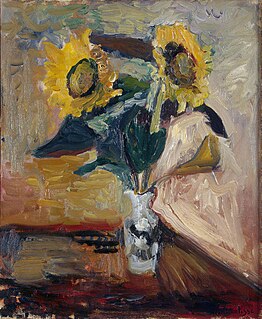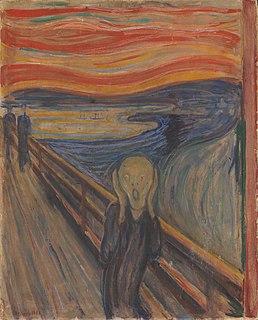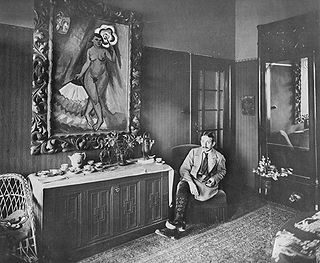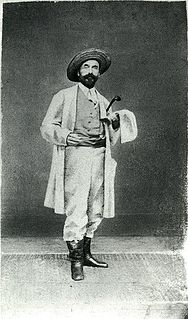
Painterliness is a concept based on the German term malerisch (painterly), a word popularized by Swiss art historian Heinrich Wölfflin (1864–1945) to help focus, enrich and standardize the terms being used by art historians of his time to characterize works of art. It is the opposite of linear, plastic or formal linear design.

Emil Nolde was a German-Danish painter and printmaker. He was one of the first Expressionists, a member of Die Brücke, and was one of the first oil painting and watercolor painters of the early 20th century to explore color. He is known for his brushwork and expressive choice of colors. Golden yellows and deep reds appear frequently in his work, giving a luminous quality to otherwise somber tones. His watercolors include vivid, brooding storm-scapes and brilliant florals.

Expressionism is a modernist movement, initially in poetry and painting, originating in Germany at the beginning of the 20th century. Its typical trait is to present the world solely from a subjective perspective, distorting it radically for emotional effect in order to evoke moods or ideas. Expressionist artists have sought to express the meaning of emotional experience rather than physical reality.

Abstract expressionism is a post–World War II art movement in American painting, developed in New York in the 1940s. It was the first specifically American movement to achieve international influence and put New York City at the center of the western art world, a role formerly filled by Paris. Although the term "abstract expressionism" was first applied to American art in 1946 by the art critic Robert Coates, it had been first used in Germany in 1919 in the magazine Der Sturm, regarding German Expressionism. In the United States, Alfred Barr was the first to use this term in 1929 in relation to works by Wassily Kandinsky.
Action painting, sometimes called "gestural abstraction", is a style of painting in which paint is spontaneously dribbled, splashed or smeared onto the canvas, rather than being carefully applied. The resulting work often emphasizes the physical act of painting itself as an essential aspect of the finished work or concern of its artist.
Post-expressionism is a term coined by the German art critic Franz Roh to describe a variety of movements in the post-war art world which were influenced by expressionism but defined themselves through rejecting its aesthetic. Roh first used the term in an essay in 1925, "Magic Realism: Post-Expressionism", to contrast to Gustav Friedrich Hartlaub's "New Objectivity", which more narrowly characterized these developments within German art. Though Roh saw "post-expressionism" and "magic realism" as synonymous, later critics characterized distinctions between magic realism and other artists initially identified by Hartlaub and have also pointed out other artists in Europe who had different stylistic tendencies but were working within the same trend.
Neo-expressionism is a style of late modernist or early-postmodern painting and sculpture that emerged in the late 1970s. Neo-expressionists were sometimes called Transavantgarde, Junge Wilde or Neue Wilden. It is characterized by intense subjectivity and rough handling of materials.

Hermann Max Pechstein was a German expressionist painter and printmaker, and a member of the Die Brücke group.

Joseph Pisani is an American contemporary artist, abstract painter, and photographer, living in Switzerland.

German art has a long and distinguished tradition in the visual arts, from the earliest known work of figurative art to its current output of contemporary art.

Lyrical abstraction is either of two related but distinct trends in Post-war Modernist painting:

Crime in Switzerland is combated mainly by cantonal police. The Federal Office of Police investigates organised crime, money laundering and terrorism.

Giovanni Ulrico Giacometti was a Swiss painter. He was the father of artists Alberto and Diego Giacometti, and architect Bruno Giacometti.

SWI swissinfo.ch is a ten-language news and information platform produced by the Swiss Broadcasting Corporation. Its content is Swiss-centred, with top priority given to in-depth information on politics, the economy, the arts, science, education and direct democracy. Switzerland's international political, economic and cultural relations are other key points of focus. The website has ten language versions.
SIKART is a biographical dictionary and a database on visual art in Switzerland and Liechtenstein. It is published online by the Swiss Institute for Art Research (SIAR). Conceptually and in content, it is an expanded and continually updated online version of the SIAR's 1998 Biographical Lexicon of Swiss Art, which featured 12,000 short entries and some 1,100 detailed biographical articles.

FrankBuchser (1828–1890) was a Swiss painter. He is noted for his portraits of notable American figures of the post civil war period and for his works with Oriental themes.
Willi Dreesen was a Swiss painter and sculptor.
Boston Expressionism is an arts movement marked by emotional directness, dark humor, social and spiritual themes and a tendency toward figuration strong enough that Boston Figurative Expressionism is sometimes used as an alternate term to distinguish it from Abstract Expressionism, which overlapped.
Robert Indermaur is a Swiss painter and sculptor.

Ignazio Cassis is a Swiss physician and politician. He is affiliated to the FDP The Liberals and was elected to the Federal Council of Switzerland on 20 September 2017. He has served since 1 November 2017 as head of the Department of Foreign Affairs.














